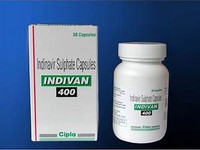indinavir
CLINICAL USE
Protease inhibitor:Treatment of HIV infection, in combination with a nucleoside reverse transcriptase inhibitor
DOSE IN NORMAL RENAL FUNCTION
800 mg every 8 hours
PHARMACOKINETICS
DOSE IN RENAL IMPAIRMENT
GFR (mL/MIN)
DOSE IN PATIENTS UNDERGOING RENAL REPLACEMENT THERAPIES
IMPORTANT DRUG INTERACTIONS
Potentially hazardous interactions with other drugs
ADMINISTRATION
Reconstition
–
Route
Oral
Rate of Administration
–
Comments
Drink 1.5 litres of water in 24 hours .380 indinAVirGive 1 hour before, or 2 hours after food, or with a low fat meal with water
OTHER INFORMATION
If giving with didanosine, leave 1 hour between each drugMild renal insufficiency is usually due to crystalluria, but a case of interstitial nephritis has been reportedIf nephrolithiasis with flank pain occurs (with or without haematuria), temporarily stop therapy (e.g. for 1–3 days)
